
Vines plants are a special category of indoor plants. And not just because of their impressive size. The flexibility and length of their shoots make them the most widely used species, able to cope with any role. Hanging planters are a classic. But limiting them to cascading vines is not a good idea. Interesting shapes on green walls, screens, partitions, supports, camouflage. You can find vines for every role. However, if you want to achieve a more lush and huge effect as soon as possible, go for the fastest growing vines, which are also far from the easiest and least necessary.
All Vines plants can be described in varying degrees as fast-growing plants. After all, the presence of long branches provides a completely different set of green substances. But even climbing species have their record-breakers. Fast-growing species are considered climbing, scaling, and creeping species if they can grow more than 20 inches (0.5 m) in length in a year.
The most popular climbers do not stop even at this height, gaining about 40 inches (1 m) in a year, sometimes more. They quickly envelop supports, drape screens, create green walls and cover all nuisances. They grow before your eyes. But they can only do so if they do it right.
For cultures that can grow more than 8-12 inches (20-30 cm) per year to display their beauty fully, you must create really good conditions for them. And know exactly the requirements and habits of each species. The keys to fast growth are good light (in the shade, even shade-tolerant species will develop poorly), no interruptions for watering, timely fertilization, and spot-free leaf cover. Lack of water and lack of nutrients both have the same effect on growth.
If you pay special attention to site selection, temperature, dormancy, watering, air humidity, nutrition, soil, pruning, and transplanting, without deviating in any way from the recommendations. In that case, you will be able to guarantee good growth every year.
Our selection of fast-growing favorites, if well cared for, will amaze you by increasing shoot length and foliage number at an amazing rate.
Passionflowers
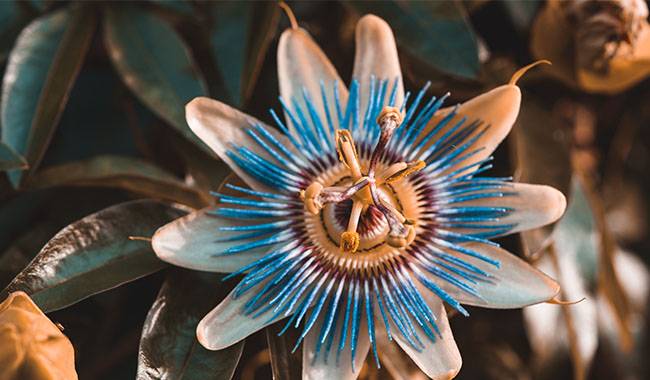
Exceptional in every sense of the word, Passionflowers can grow at a rate of up to 4 inches (10 cm) per day, not to mention the rate at which it sprouts in a single season.
This evergreen vine is known for its huge, fancy, orderly star-shaped flowers with an ornate corolla around the pistils and stamens. But the beauty of the glossy, five- to seven-leaved, dark green leaves up to 8 inches (20 cm) in diameter should not be underestimated.
Passionflowers attach themselves to stands and surfaces with tendrils that hardly ever stop, require regular heavy pruning, and rarely fit in windows. However, a cool dormancy period without fertilizer is conditional, and it adapts to light much better than its reputation.
Devil’s ivy (Epipremnum aureum)

Epipremnum aureum can grow over 40 inches (1 meter) shoots per year and is the most popular of the Epipremnum scindappus species. It is probably the most common and versatile of the vines.
The heart-shaped young leaves are up to 8 inches (20 cm) long, often decorated with mottled white or gold spots, and rarely change to large leaves with many slits for adult plants. This is true, at least for indoor forms. Climbing slender branches attached to the stand with their adventitious roots can even create evocative images on the stand.
Epipremnum can only retain its graphic beauty in soft, bright light. And it does not tolerate too much water. But the standard care for thermophilic Epipremnum does not include the requirement for the tropical humidity.
Senecio macroglossus (wax ivy)
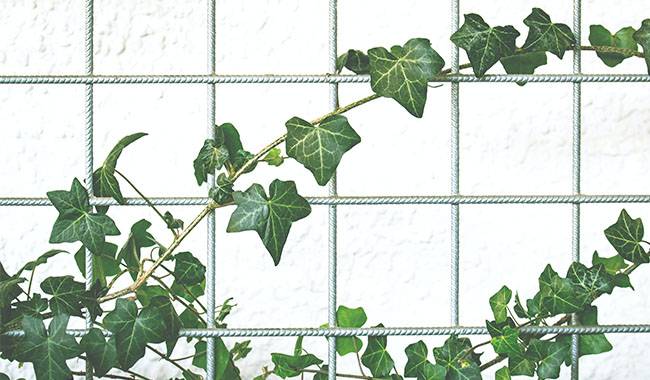
Senecio macroglossus is one of the most extravagant of the crucifers. It is difficult to recognize as a relative of the Raleigh crucifer and other species of the amazing genus Senecio. But with time, its terrific growth rate and dominance became apparent.
The large tongue crucifer resembles Hoya or Hedera helix in appearance. It is attractive for its thick, if fleshy, intensely glossy, leathery, eccentric, three-lobed leaves even in its simple form. And in the most popular mottled form, white spots, veins, and patterns create a memorable effect. The slender shoots have almost no aerial roots and can twine around slender support. This plant does not bloom indoors.
This cross can only show its beauty in the brightest light, with good ventilation, adequate watering, and high air humidity.
Philodendron hederaceum
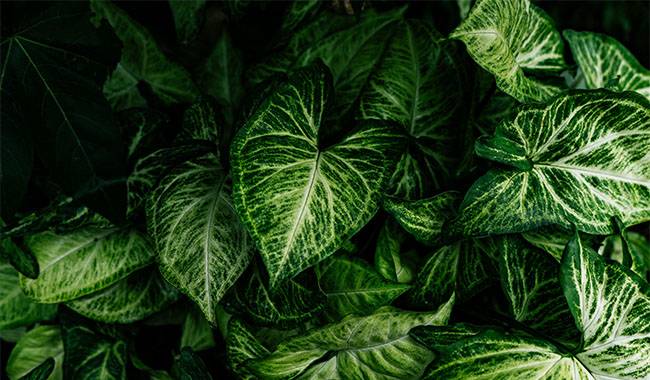
Philodendron hederaceum has an annual growth of 40 inches (1 m) or more. But this is not the only thing that distinguishes this unique species from its relatives. But it is the most important. It is due to its rapid growth that Akebia is valued all over the world. However, the development speed allows leaving only plants of a certain age and size in a room format.
Behind the huge, showy forest green foliage, the long shoots of climbing plants are barely visible. Broadly heart-shaped and leathery, they soon double in size and appear as splendid shields.
Philodendron hederaceum requires coarse, special soil containing peat, bark, and sphagnum. The decorative nature of the leaves depends directly on the quality of the fertilizer and the stable air humidity. However, this vine does not have a dormant period.
Akebia (Chocolate vine)
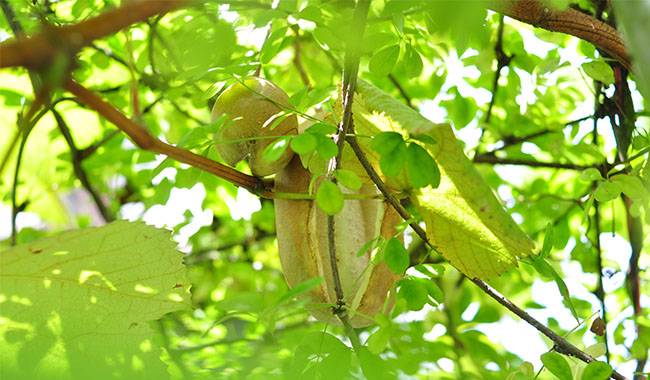
Akebia is a chocolate vine that not everyone dares to grow in a room yet because it is a real giant even in pots. In the wild, the annual growth rate is 40-120 inches (1-3 meters), in the room only slightly lower. However, it is easy to keep the plant growing.
Akebia is named for its dazzling “Chocolate vine.” The original purple female flowers and light pink male flowers bloom during the comfortable April to August flowering period. And during this time, you can’t leave Akebia alone as the scent nuances make you want to unwind.
Although Akebia is not sturdy, the beauty of this semi-evergreen topiary with purple shoots that are easily twisted around any support with five-lobed shiny leaves in a season is more than enough.
Akebia needs cool overwintering conditions, and you can’t expect success without it. It likes sun and air and is not afraid of drafts but is sensitive to humidity. It thrives well in low humidity.
Hedera helix (Common ivy)
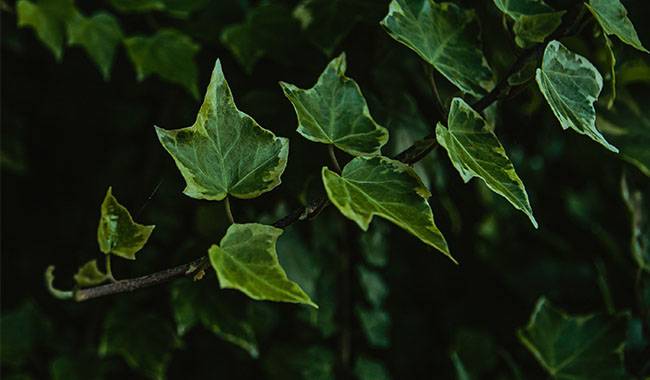
The well-known garden Hedera helix does not lose its ability to grow fast when moved indoors. But, of course, indoor varieties are more compact, interesting, versatile, and slow. But only at first. Hedera helix grows very slowly for the first 2-3 years, but then it can increase by 40 inches (1 meter) per year.
Hedera helix needs almost no introduction. It is the most versatile, unpretentious, and reliable ampelopsis, window coverings, groundcovers, and screen plants in rooms, offices, and formal institutions. Three, five, or seven-lobed, interestingly shaped, with dense, shiny skin and light-colored veins or patterns. Indoor Hedera helix shoots up to 16.4 feet (5 m) in length are rare because they are usually limited to a manageable size for densification purposes.
For the Hedera helix to show its beauty, you need to remember to spray with water, moderate humidity to prevent overheating, and a consistently moist substrate. It prefers moderate temperatures, bright light, and cool overwintering conditions in which it simply blooms.
Syngonium auriculata or Auricle
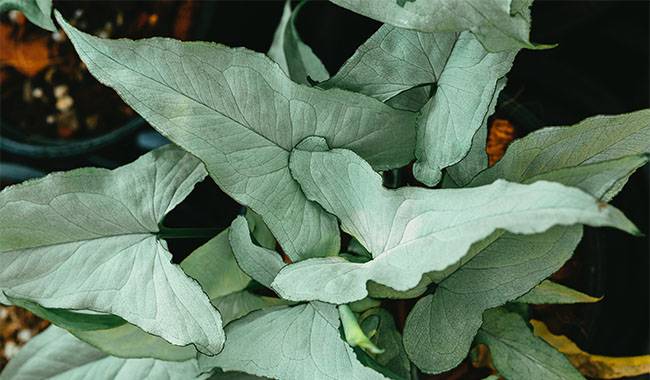
Syngonium auritum can grow 27-35 inches (70-90 cm) per year. Particularly spectacular is the growth of cuttings, which transform before your eyes, tirelessly bringing in new leaves. Syngonium is, of course, inferior to Epipremnum but will still appeal to those who expect fast results.
Syngonium auriculata is derived from the peculiar shape of the large leaves’ lateral segments, which are up to 12 inches (30 cm) long and triangular. This evergreen vine has glossy leaves, very long cuttings up to 10 inches (50 cm) in length, and a surprisingly deep blue color with light stripes. Many varieties have a purple underside. Leaves come in different shapes and sizes at different ages. The shoots are very long, reaching 16.4 feet (5 m) even in cultivation.
It can only be grown on poles. It grows well at room temperature all year round. This species is afraid of cold weather and can even reach 64 °F (18 °C). However, it grows perfectly indoors and on windowsills in the north, has average soil moisture requirements, and adapts well to low humidity.
Other Fast-growing Indoor Vines
These plants are not the only ones that can grow 27 inches (70 cm) or more per year. The millennial favorite Hoya, the good old classic Tradescantia (Spiderwort), the ever appropriate Cissus rhombifolia (Cissus alata) with its unique green clouds, the unexpectedly elegant Ceropegia, the dazzlingly beautiful lush, and beautiful native flowering Clerodendrum chinense, the unforgettable Mandevilla (Rocktrumpet), the unforgettable Stephanotis Jasmine (Stephanotis floribunda) from Madagascar, which is also surprisingly fast.
You can also give the record-breaking plants that grow more than ten feet in a few months, the Ipomoea and Clockvines that are just starting their indoor careers, a chance.







